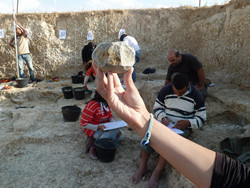The hominids of Ain Hanech
Ain Hanech is a palaeoanthropological site, located about 100 km inland from Algeria's Mediterranean coast on the eastern High Plateaus. The sedimentary basin contains the oldest archaeological evidence of inhabitants in North Africa. The EU-funded PALEONORTHAFRICA (Studies of early hominid adaptation and dispersal into North Africa: Archaeological investigations at the Plio-Pleistocene site of Ain Hanech, Algeria) project aimed to investigate early hominid behaviour in North Africa. The study involved determining the timing of early human habitation and detailing their behaviour, including subsistence activities and the role of stone tool technology enhancing diet. The research was also intended to reconstruct the palaeoecology of the area. Finally, the team aimed to study site formation processes and to survey new sites. The techniques used for dating the site included palaeomagnetism, electron spin resonance and large mammal biochronology. Results showed that early hominids were present in the area earlier than previously believed, between 2.3 and 1.7 million years ago. The date was also the earliest known for hominid habitation anywhere in North Africa. The environment at the time was a relatively dry, open grassland, in transition to a drier climate. The change would have affected hominid food foraging activities, with the river network providing valuable food and other resources. The stone technology used was simple , and virtually identical to that known from other contemporary hominid sites in east Africa. The tools would have been sufficient for butchering animal carcasses and for obtaining bone marrow. Bone surface modification studies showed evidence of such meat processing. The researchers also raised the possibility of hominid migration to Europe via North Africa. Other project activities included training local university students in archaeological and palaeontological fields and laboratory techniques. Several PhD students studied Ain Hanech artefacts and fossil bones for their theses. The project therefore helped modernise palaeoanthropological studies in Algeria by exposing local students to international researchers. The project also helped establish connections with several Algerian agencies, including a permanent hominid exhibition at Bardo National Museum. Such a relationship should benefit local and European research. The PALEONORTHAFRICA project resulted in new understanding of hominid habitation in North Africa. Its work also clarified the environmental and technological skills of the time.
Keywords
Hominids, Ain Hanech, North Africa, archaeology, palaeontology, palaeoecology, early hominid occupation



